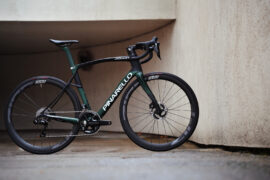The Fuel EXe made a massive impact on the e-bike market when it launched last year, blurring the lines between assisted and “acoustic” rides. It was described in the cycling media as a “game changer” and, having spent time on it on the trails and talked to customers about how it performs, we can say that it truly is. At the same time, Trek Rail is hugely popular with e-bike riders and continues to be the weapon of choice for those who want epic days shredding on the trails.
The overview
Put simply, Rail (pictured) is a lot of bike.
Long travel suspension front and rear, powerful motor, excellent range, chunky tyres… everything about it is big. It instils confidence on technical trails and really looks after you in areas where your riding ability could be better. This is every inch the full fat e-bike.
The Fuel EXe takes the e-bike concept and turns the dial back a little. It offers just the right amount of assist to help you up the hills and prolong those days in the saddle. The motor is subtle and silent, and the overall experience is of a nimble and sure-footed full suspension bike.
The specs
Rail is a full-assist e-MTB with a Bosch Performance Line CX motor that provides up to 85 Nm of torque and a battery with 500 to 750 Wh of power, depending on the model. There are four power modes and the range on a full charge is up to six hours, depending on how much assist you’re using. Based on Trek’s Slash enduro bike, Rail has slack geometry and a full suspension set-up with 150mm of rear travel and a 160mm fork.


Trek Fuel EXe (pictured) offers mid-level assist, replicating the more natural feel of a traditional mountain bike and feeling very much like its analogue older brother, the Fuel EX. It features a TQ harmonic pin ring motor that provides up to 50 Nm of torque and weighs in at only 1.85kg. The 360 Wh battery provides up to five hours of power. The Fuel EXe’s suspension offers a little less travel than the Rail, with 140mm on the front and 150mm on the rear.
When it comes to weight, the Rail is heavier than the Fuel EXe due to its larger frame size, bigger battery and extra suspension travel. This extra weight can be beneficial when tackling more technical terrain as it provides better stability but, having said that, despite being lighter, the Fuel EXe does feel nicely anchored when you’re attacking the descents and pushing it into berms.
In terms of connectivity, Trek developed a new app called Trek Central for the Fuel EXe, which allows the customisation of assistance levels and other motor parameters. The app also learns from your riding style to estimate how much range you’ve got left in the battery. The display in the top tube gives information on battery life, range and other data.
Trek Rail uses the Bosch eBike Flow app to monitor motor performance and also enables you to change the support dynamics and power output levels to suit your riding style. It can track your ride stats, with automatic recording once you start to ride.
Which is right for you?
As always, the choice is ultimately about the kind of riding you want to do, your fitness and technical ability. Rail will handle pretty much any trail you can throw at it and gives you a lot of confidence on the rough stuff. The full assist powers you up the hills and offers a hefty boost over an extended period of time. Fuel EXe feels and sounds just like an analogue bike but offers just enough assist to keep you riding for longer, while still ensuring you get a great workout and have the energy to enjoy what you’re doing. We think this will be the gateway to e-bikes for lots of riders who are happy to sacrifice some of the assist for a more natural feel.
Compare Trek Rail and Fuel EXe for yourself and get advice from our expert team in store in Bedford.





